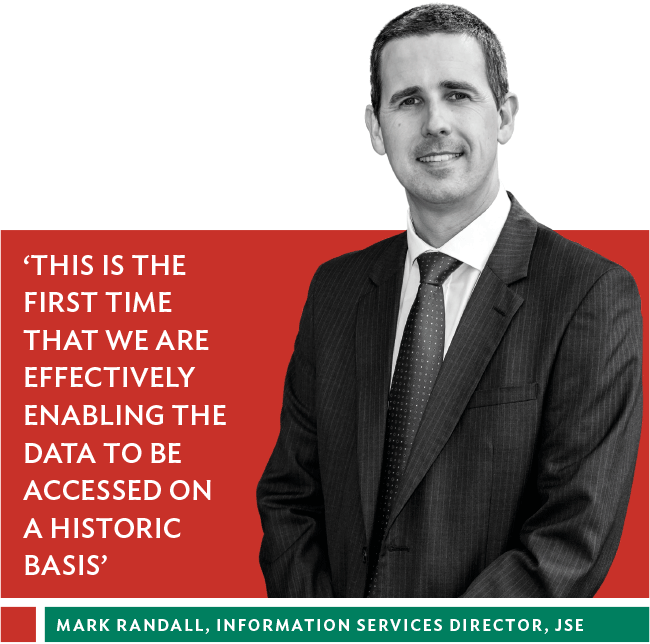Past performance, as any investor will tell you, is no guarantee of future returns. But the same investor will also tell you that historical data is absolutely vital when it comes to informed investment decision-making. ‘Sophisticated players, like hedge funds that have distinct business models that encompass high-frequency trading, will not generally trade on a market until they have thoroughly tested that the algorithms-based solutions underpinning their trading strategies are able to identify trading revenue opportunities,’ says Neil Vendeiro, Market Data Product Owner, JSE. ‘Access to historical tick data is thus, to these kinds of players, an entry ticket to the “game”.’
In June, the JSE began offering historical equity, equity derivatives and currency derivatives tick data in the cloud. This service means that clients, data vendors, investors and traders are now able to access historical data more swiftly. ‘The historical tick data will enable clients, traders and investors to assess trading opportunities; strengthen their market insights and improve risk-mitigation intelligence based on both the market and various individual stocks’ past performance; support compliance reporting with more extensive data; and conduct other valuable trading-related analyses,’ says Mark Randall, JSE Director: Information Services.
Randall adds that the data is currently only really available from the JSE on a real-time subscription basis to support trading. ‘This is the first time that we are effectively enabling the data to be accessed on a historic basis, which opens a number of new channels,’ he says.
The JSE partnered with the CME Group, one of the world’s leading and most diverse derivatives marketplaces to house the cloud solution offering on the CME DataMine platform. ‘Partnering with a global exchange that is delivering successfully allows us to get cutting-edge market data services to our clients, without having to re-invent the wheel,’ says Randall. ‘Over and above the speed-to-market benefit, it also means we’re benefiting from the continuous knowledge building and sharing that comes from this partnership.’
One of the key benefits of the CME DataMine platform is that it is largely self-service. This means potential clients can dip into JSE data without lengthy contracting and administrative processes. ‘There are also fewer logistical headaches in accessing the data, as the solution is internet-based,’ adds Vendeiro. ‘In addition, instead of just offering a once-off data purchase product, the solution will allow users to have ongoing access to the data, which is especially useful for those who want to analyse the data on a regular basis.’
Self-service market data platforms are still a relatively new development, so this offering places the JSE ahead of many leading global bourses. ‘Exchanges have generally left it up to specialist data vendors to provide this kind of data and associated value-add services,’ says Vendeiro. ‘But recognising the value of this data and wanting to provide a more complete service, a handful of exchanges have started to move into this space in a more meaningful way. The JSE is well-positioned against this trend.’
The JSE offers full market depth Level 2 tick data for three of its markets: the JSE equity market, equity derivative market and currency derivatives market. ‘This means we provide a detailed record of every market order – i.e. buy instruction and sell instruction – as well as trade, for example, transaction price,’ says Randall. ‘Equity market data is provided on a daily basis back to September 2016, and the other markets are available from April 2019.’
Migrating data offerings into the cloud are a key part of the JSE’s ICT strategy. ‘It reduces infrastructure cost and improves flexibility,’ says Randall. ‘This particular offering is the first step in looking at how we provision all of our market data services. Ultimately, the JSE would look to utilise cloud services to start bringing analytics and insights to clients, rather than just raw data.’









